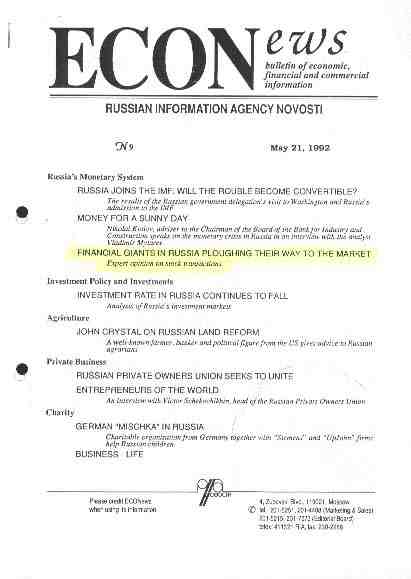![]()
Publications. Financial Articles : # 13
| FINANCIAL GIANTS IN RUSSIA PLOUGHING THEIR WAY TO THE MARKET | |
 |
Article in the Bulletin
of economic news of "ECO-NEWS", RIA "NEWS" (Russian News Agency), # 9,
21 of May 1992, page 5-6, Section "Russia's Monetary System" Author - Dmitry
Lyubomudrov |
![]()
By Dmitry LYUBOMUDROV, expert on stock-exchange transactions,
Executive Director of Dmitry and Andrei Ltd
The boom at Russian exchanges in autumn 1991 was followed by a sharp downturn in January
and February 1992. However, spring signalled a thaw on the Russian stock and commodity
exchange market, with trading volumes picking up slightly.
According to observations, only large-scale transactions are worthwhile and productive. As
a rule, several market-makers shape the flow of transactions: shares are issued by the
most prominent companies and banks, including AvtoVAZbank, Incombank, Unicombank, as well
as the Russian Raw Materials and Commodity Exchange and Moscow Commodity Exchange. In
terms of scope, transaction flows may comprise no more than several deals a week, which
are nonetheless regular and embrace several exchanges simultaneously. Judging from the
nature of the flow one can form a clear picture of stock and commodity market trends. In
turn, this serves to build the trust of small potential investors in the stability of the
market and lure them into investing their money in exchange flows.
The formation of exchange requires major investments (of up to several tens of million
roubles) by large commercial structures. Meanwhile, such investment efforts prove highly
profitable, with average yields varying from 200 to 1,000 per cent. The investment pattern
usually relies on the so-called "boosting" principle, which essentially boils
down to the following scheme. A streamlined flow of investments for a total of 10,000,000
roubles a month gradually involves the funds of small investors, which constitute rather
impressive amounts — between 100 and 500 million roubles.
Analysis of exchange activity in Russia indicates that the organiser of the flow (who
purchased shares on the bull market) has been given a chance to double his capital, while
investors who joined the flow in mid-way stand to gain less, but, at the same time, bear
smaller overhead expenses.
For the time being, the Russian stock market may be descri bed as just emerging. Large
commercial entities capable of investing big sums of money may expect major profits.
Meanwhile, the profits of companies with profitability rates of between 20 and 30 per cent
are normally nullified by inflation. Therefore commercial and purchasing activity is
considered as super-profitable among Russian-based companies. This notwithstanding, the
most far-sighted business people started looking for other high-yielding areas when the
market was lively.
The majority of state-sector enterprises in Russia will be transformed into joint-stock
companies in the near future. For the time being, private joint-stock companies are the
most popular choice. At the same time, enterprises become increasingly aware that only
open-type joint-stock companies may be instrumental for obtaining required financial
resources in the future. Of course, some prefer to stake everything on long-term loans,
which cannot be obtained now, as banks are highly reluctant to bear the burden of
socio-political and economic risks.
Business people are, however, with even greater insight, switching over to holding
companies. The Russian Raw Materials and Commodity Exchange (RRMCE) represents perhaps the
most graphic example of Russian commercial structures, which seek to establish new
entities. Over a relatively short period of time, the RRMCE has managed to create such
major investment companies as the Military-Industrial Investment Company (MIIC), RINACO
(Russian Investment Company), NIPEC, Zolotye Vorota and many others with six digit
statutory capitals. Relying on the "boosting" principle, these newly-established
structures manage to mobilise huge funds which are virtually not subject to shareholders'
control and are channelled into secondary market flows and utilised to diversify the
business profile of the main organisers.
Consequently the latter group of entities are steadily approaching the stage when they may
legitimately be defined as transnational corporations. Although they are few and far
between in Russia and the Commonwealth of Independent States, they are gaining in
popularity, owing to the strong support they enjoy from the government.
![]()